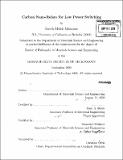Carbon nano-relays for low power switching
Author(s)
Milaninia, Kaveh Mehdi
DownloadFull printable version (28.41Mb)
Other Contributors
Massachusetts Institute of Technology. Dept. of Materials Science and Engineering.
Advisor
Marc A. Baldo and Francesco Stellacci.
Terms of use
Metadata
Show full item recordAbstract
In this thesis two unique carbon based nanoelectromechanical switches or carbon nano-relays are demonstrated as a toolkit for investigating NEMs based low power switching. The first is a vertical carbon nano-relay, consisting of a vertically aligned carbon nanotube/fiber (CN) between two contacts and operated by pull-off, and the second, a double graphene switch, consisting of two electromechanically actuated stacked layers of polycrystalline graphene. Vertical carbon nano-relays were initially prototyped by inserting a CN between two contacts through the use of a nanopositioner. The prototype demonstrated pull-off operation and multiple switching. To our knowledge this is the only example to date of a multiple-use NEMs switch that operates with pull-off. Next a wafer integrated device was fabricated. Although pull-in was demonstrated in these integrated devices, pull-off was not possible primarily due to limitations in CN growth, which were also investigated. In the work on a double graphene switch we demonstrated an electromechanical switch comprising two polycrystalline graphene films, each deposited using ambient pressure chemical vapor deposition (CVD). The top film is pulled into electrical contact with the bottom film by application of approximately 5V between the layers. Contact is broken by mechanical restoring forces after bias is removed. The device switches several times before tearing. Demonstration of multiple switching at low voltage confirms that graphene is an attractive material for electromechanical switches.
Description
Thesis (Ph. D.)--Massachusetts Institute of Technology, Dept. of Materials Science and Engineering, 2009. Cataloged from PDF version of thesis. Includes bibliographical references (p. 147-153).
Date issued
2009Department
Massachusetts Institute of Technology. Department of Materials Science and EngineeringPublisher
Massachusetts Institute of Technology
Keywords
Materials Science and Engineering.